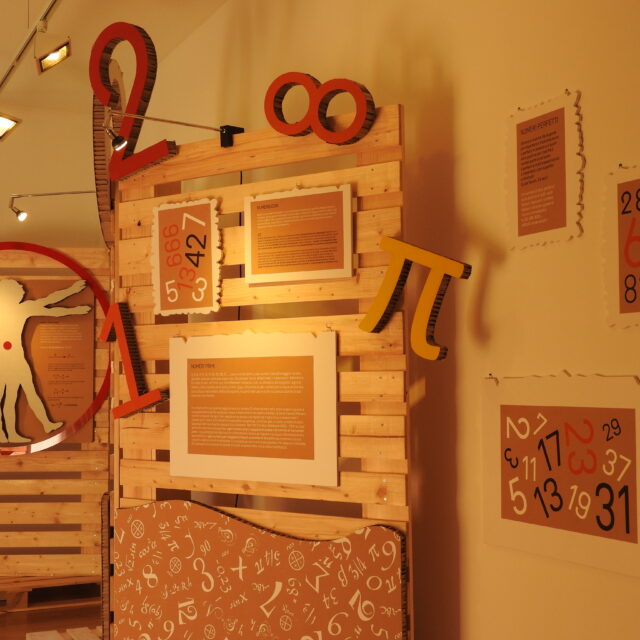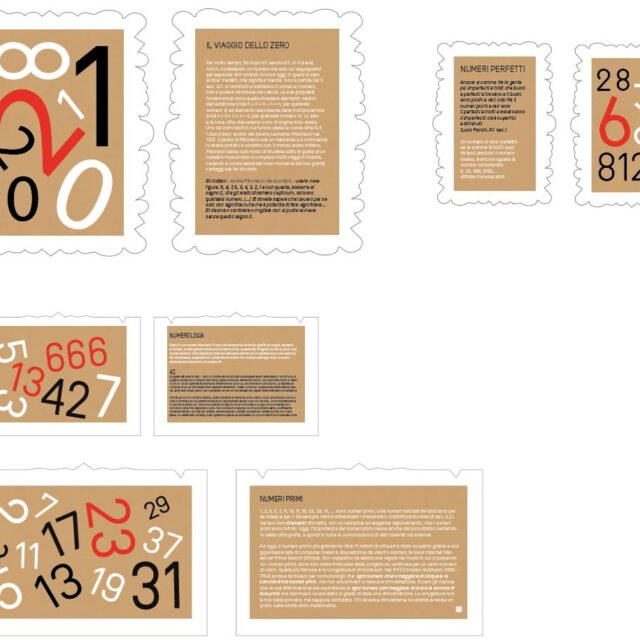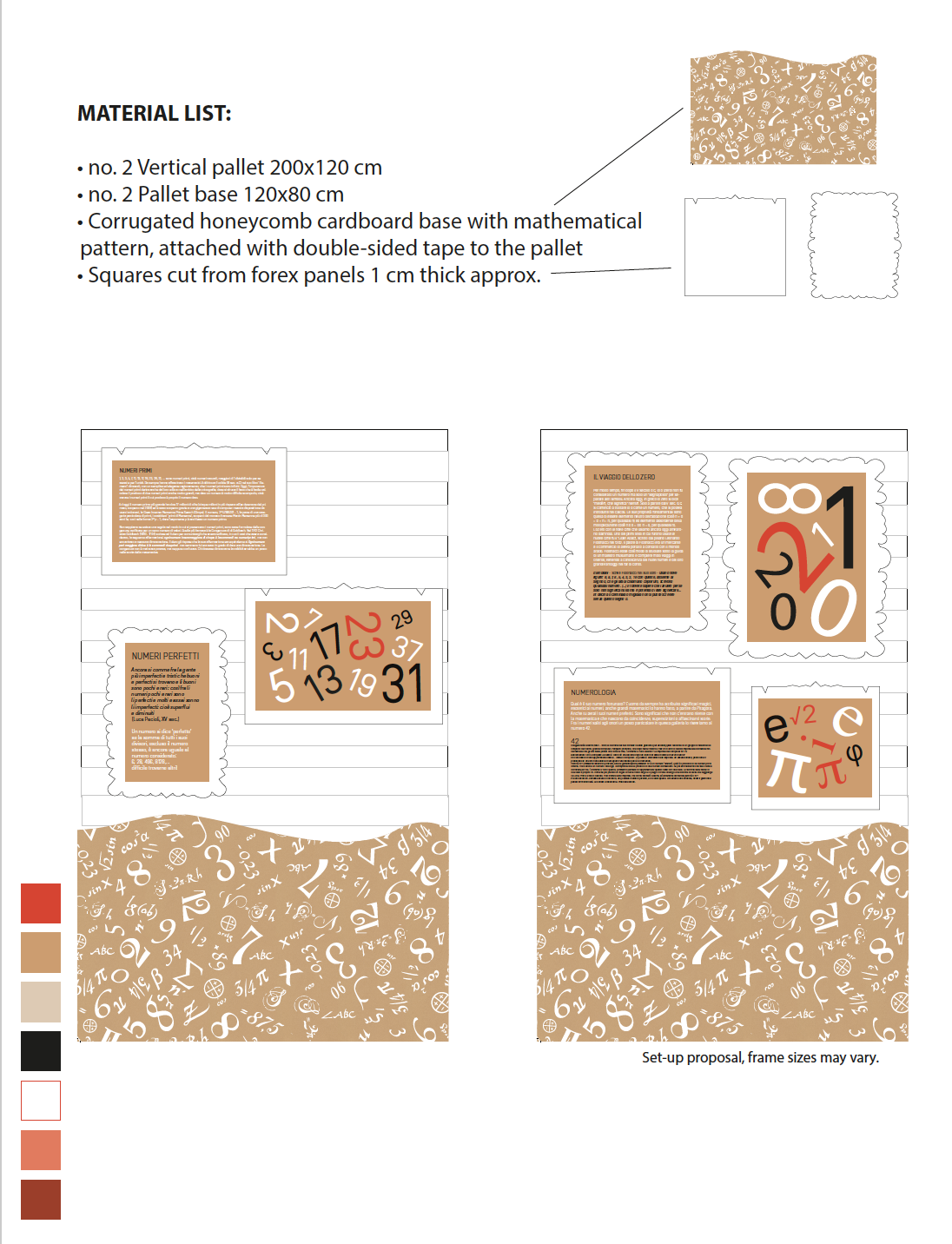Explore the gallery with framed portraits of some remarkable numbers: e, pi, infinity, zero,…


Nepero’s number, often denoted by the letter “e,” is one of the most important mathematical constants and is used in several areas of mathematics, science and engineering. Its approximate value is about 2.71828. Nepero’s number is an irrational and transcendent constant, which means that it cannot be represented as a division of integers and is not a solution of any algebraic equation with integer coefficients. This makes it a very special number in number theory.
Nepero’s number is defined by the infinite series:
e = 1 + 1/1! + 1/2! + 1/3! + 1/4! + 1/5! +…
Where “!” (factorial) represents the product of all positive integers up to the specified number. For example, (5 factorial) is equal to 5 x 4 x 3 x 2 x 1.
Nepero’s number naturally emerges in various mathematical contexts, such as differential and integral calculus, complex analysis, differential equations, probability theory, and exponential calculus. It is widely used in exponential growth and decay calculations, as well as in continuous interest evaluation in financial mathematics.
The name “Nepero’s number” comes from the surname of Swiss mathematician Leonhard Euler, who frequently used the nickname “Nepero.” However, the use of the name “and” to represent this constant was introduced by English mathematician Charles Maclaurin in 1718.
The number π (pi) is a fundamental mathematical constant that represents the ratio of the circumference of a circle to its diameter. It is an irrational constant, which means that its decimal value cannot be accurately expressed as a fraction and has an infinite, non-periodic representation. The symbol “π” is derived from the Greek letter “pi” (π), which is the first letter of the Greek word “perimetros,” meaning “circumference.”
The approximate value of π is 3.14159265358979323846… and so on, but there is no exact representation in the form of a fraction. The fraction 22/7 is often used as an approximation of π, but it is only an approximation and is not exact.
The number π is used in many areas of mathematics and science, including geometry, trigonometry, calculus, and physics. It is one of the most important mathematical constants and appears in many fundamental formulas and relationships. For example, in the area of a circle, the area A is given by A = πr2 where is the radius of the circle.
There are memorization competitions for memorizing the decimal digits of π, in which people try to remember and recite as many decimal digits as possible. The world record for memorizing the decimal digits of pi is about 70,000!
With the advent of computers, it has been possible to calculate billions of decimal digits of π, and this activity has been performed by many enthusiasts and researchers. However, for most practical applications, a few decimal digits of π are sufficient.
Feast of Pi: March 14 (3/14 in month/day format in the United States) is often celebrated as “Pi Day” because the date corresponds to the first three digits of π (3.14). Because of the similarity in the pronunciation of the words “pi” and “pie” (meaning “cake” in English), it is common to see pictures of celebratory cakes on Pi Day.
Encryption Ratio: The number π is often used in cryptography and computer security to generate random sequences and to create encryption algorithms.
The “zero number” is an integer representing the absence of value or the null quantity. It is a fundamental concept in mathematics. The number zero is the only number that is neither positive nor negative and plays a crucial role in the number system and mathematical calculations.
The concept of zero has a history going back to many ancient cultures, including the Babylonians and Egyptians, who had symbols to represent emptiness or absence. The Maya also had a symbol for zero, used in a positional sense. However, the positional numbering system with zero as we know it today was developed primarily in India. Indian mathematicians, including Brahmagupta and Aryabhata, developed the concept of zero as a number and as a positional sign in the Indian number system. They introduced the concept of “sunya” or “shunya,” meaning “emptiness,” and began using the symbol “0” to represent this concept.
Zero was then transmitted to the West through Arab culture and trade. Arab mathematicians adopted the Indian system and introduced it to medieval Europe. Initially, the concept of zero was treated with skepticism in Europe. Some European mathematicians saw it as “nothing” and not as a real number. It took some time before the concept was fully accepted.
The introduction of the number zero and the positional number system revolutionized calculus and algebra, making calculations easier and enabling the development of more powerful methods for solving equations and performing mathematical operations.
In addition to being a number, the concept of zero has taken on a broader meaning in philosophy and number theory, often representing the idea of emptiness, absence or beginning. In engineering and science, the concept of zero is essential for representing energy levels, temperatures, and other physical quantities. It is also essential for representing binary systems in computers.
In mathematical operations the zero is the neutral element in the sum. Adding zero to any number will not change the value of the number. For example, 5 + 0 = 5. In addition, any number raised to the power of zero will remain equal to itself n0 = 1.
The number one is the simplest of the integers and is the fundamental unit in the number system. It is the first and smallest positive integer and represents the idea of singularity, individuality and uniqueness. The mathematical symbol for the number one is “1,” which is derived from ancient Roman notation and at the same time is reminiscent of ancient notches in wood.
In mathematical operations one is the neutral element in multiplication. Multiplying any number by one will not change the value of the number. For example, 5 x 1 = 5. In addition, any number raised to the power of one will remain equal to itself and also one raised to the power of any number will remain one 1n = 1 .
In the binary (base 2) system used in computers, any number is represented by a sequence of “1” and “0” bits. This bit is essential for representing digital data.
The number one is not considered a prime number, since prime numbers must have exactly two distinct positive divisors. The number one has only one divisor: itself.
In mathematics, the symbol called the “infinity symbol,” looks like an upside-down number 8 and represents a very interesting concept: the idea of infinity.
For example, think of natural numbers. Imagine listing them: 0, 1, 2, 3, 4 and so on. No matter how far we go, we will never run out of numbers, will we? After a number by adding 1 we always get a next number. This is kind of like the infinity symbol. It tells us that we can keep counting and go on forever.
The infinity symbol precisely represents this idea of “infinity of elements,” of “without end.”
Besides counting, the infinity symbol can be used in many other situations. In more advanced math problems, you will see it in limits, which are like saying “what happens when something gets closer and closer to infinity?” Even when we talk about curves approaching a line without ever touching it, we can use the infinity symbol to represent this concept. Thus, the infinity symbol describes something that continues without ever ending. It is a bit like thinking of the horizon that extends to infinity, or as we have already seen the sequence of numbers that continues forever.
When you see the infinity symbol, you are thinking of something that is endless. It is a bit like an open door to a world of possibilities that has no boundaries!
Educational Insights
The numbers and of Neperus and pi, being irrational, and the complex topic of infinity, are not explicitly included in the “Ticino Compulsory School Curriculum” as far as elementary school is concerned, but are “remarkable numbers” that are dealt with in later school levels. Instead, since elementary school, the numbers 0 and 1 are addressed in depth, both as elements of the set of natural numbers, emphasizing for 0 the fundamental role in our positional decimal system, and as neutral elements of some operations.
Proposing activities related to “remarkable numbers” allows us to pursue several purposes:
– grasp the characteristics of specific elements of our number system;
– to understand more deeply the structure of our decimal positional number system;
– to know some important mathematicians of the past who dealt with these remarkable numbers, their discoveries and their relevance from a scientific and historical point of view;
– know how to delve into a specific mathematical topic…
With regard to elementary schooling, the different numbering systems of the various cultures that have succeeded each other over time, and the counting tools used by them, are considered among the materials of the “MaMa-mathematics for elementary school” project commissioned by the Department of Education, Culture and Sports to the Mathematics Teaching Competence Center of the Department of Formation and Learning/High Pedagogical School in Locarno, Switzerland. These materials can be downloaded free of charge at this link: https://mama.edu.ti.ch/.
In particular, it is suggested to consult:
– the Guidelines for having mathematical, educational and historical insights related to the various number systems of the ancients. This document also presents some historical tools, including those presented here, used by various cultures. This document may also be useful for later school levels;
– the Context of Meaning “Mathematics Traveling in Space and Time“, a document in which insights are provided for designing meaningful learning situations related to mathematics from different cultures, used in different historical periods;
– the Teaching Practice “The Number Systems of the Ancients,” a document in which are collected teaching proposals relating to, among others, the number systems of primitive men, the Sumerians, the Incas, the Egyptians, the Mayans, the Babylonians and the Romans the teaching practice “Different Algorithms of Calculus“, where different algorithms are proposed, some of which have followed each other throughout history and have characterized different places; – the teaching practice “Figures and the Positional System“, where there are many ideas related to the Indo-Arabic numeral system, including the construction of a small abacus.
– the Teaching Sheets designed for learners, which can be found by setting the filter “Other Number Systems” in the teaching materials search engine. In particular, we highlight: “The Speed Race“, “Ten Notches“, “Sumerian Numbers 1,” “Sumerian Numbers 2,” “Sumerian Numbers 3,” “Sumerian Numbers 4,” “Inca Numbers 1,” “Inca Numbers 2,” “Roman Numbers 1,” “Roman Numbers 2,” “Roman Numbers 3,” “Roman Numbers 4,” “Maya Numbers 1,” “Maya Numbers 2, “The Mayan Numbers 3,” “The Mayan Numbers 4,” “The Egyptian Numbers 1,” “The Egyptian Numbers 2,” “The Egyptian Numbers 3,” “The Egyptian Numbers 4,” “Race Between Systems,” “Comparing Systems,” “Ancient Calculations,” “The Use of the Abacus,“ “Let’s Know the Abacus,” “Decimals What a Passion,” “Laura Don’t Get Distracted.”
In addition, there are 22 comics related to important mathematicians throughout history in the collection “Mathematicians in Comics,” which can be downloaded free online or purchased in hard copy published by Daedalus Publishing House. In particular, for an in-depth look at the birth of our numbering system see the comic strip by mathematician Al-Khwārizmī (9th cent.).
Also available for active middle school teachers are teaching materials called “Mathematics in History,” supplemented by student worksheets that can be downloaded from the ScuolaLab portal (where you must register to download the documents).
How to build
EXHIBIT MATERIAL:
- no. 2 Vertical pallet 200×120 cm
- no. 2 Pallet base 120×80 cm
- Corrugated honeycomb cardboard base with mathematical pattern, attached with double-sided tape to the pallet
- Rectangles cut from forex panels about 1 cm thick, to be used as a base for panels with numbers
- LASER CUT PICTURE FRAMES
